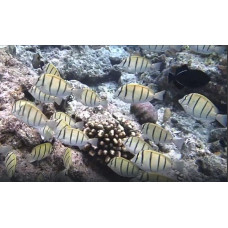Latin name
Acanthurus triostegus
Other name
Convict surgeon, convict tang or fiveband surgeonfish.
Identification
The Convict surgeonfish has a large, laterally compressed, moderately oval body. The mouth is non-retractable, small and set low on the head. The teeth are fixed, strong, close together, shovel shaped with serrated edges. There is a sharp, lanceolate spine on the tail, which is hidden in a fossa but can be raised. The scales are small. Serrated teeth on sides and top. The gill stamens are 18-22 in the anterior row, 19-24 in the posterior row.
Features of fish fins
The dorsal fin is continuous, without a notch, with 9 spiny and 22-26 soft rays. The anal fin has 3 spiny and 19-22 soft rays. Pectoral fin with 2 spiny and 13 soft rays. The caudal fin is halfmoon shaped. This species has fewer soft rays than other members of the genus.
Fish colouring
The body is olive grey with a white abdomen, often with a clear demarcation line. The Convict surgeonfish differs from other species in the genus by its inherent colouration. It has 5 narrow black vertical stripes, the first of which runs through the eye. There is a dark spot on the caudal trunk from above and below.
Distribution
They are widespread in the Indo-Pacific region. Japan, Hawaii, Taiwan (China), Philippines, Melanesia, Polynesia, Australia, South Africa.
Habitat
Marine, tropical, benthopelagic, coastal, reef associated fish. They usually live at depths between 0 and 90 metres.
Size
The maximum body length of these fish is 27 cm, but is usually down to 17 cm.
Behavior
Adults live in lagoons and coastal reefs with solid substrate. Juveniles are abundant in tidal pools. They sometimes form schools.
Food and feeding habits
They are mainly herbivorous fish, but sometimes they also feed on small benthic invertebrates. They often feed near freshwater drains, where some algae grow on rocks.
Reproduction
They form spawning groups. The size of the metamorphosis from larva to juvenile is 3.2 cm.
Fishing
This species is commercially important for fishing.
Relationship with a person
It is used as a food fish. There have been reports of ciguatera poisoning.
| Classification | |
| Phylum | Chordata |
| Class | Actinopterygii |
| Squad | Acanthuriformes |
| Family | Acanthuridae |
| Genus | Acanthurus |
| Species | A. triostegus |
| Features | |
| Conservation status | Least Concern |
| Habitat | Pelagic |
| Life span, years | No information |
| Maximum body weight, kg | No information |
| Maximum length, cm | 27 |
| Sailing speed, m/s | No information |
| Threat to people | Edible |
| Way of eating | Planktonophage |
Convict surgeonfish
Tags: convict surgeonfish


